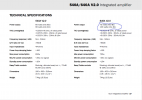jst
Active Member
- Joined
- Aug 8, 2021
- Messages
- 134
- Likes
- 39
For example Aiyima A07 , it's a class D, and default power supply/power adapter is 32v 5A, Amirm measurement is 48-61watt per channel to 8ohm speaker, or 122 watt in total, while the power consumption is 32x5=160 watt. So it's comparable from power consumption on the adapter and watt to speaker output.
But I have CA Azur640A, it's a class AB, power consumption is 600 watt according to spec and speaker output is 65 watt per channel 8ohm. Why does it take so much power if the output to speaker is much less ?
Or power consumption and speaker wattage is calculated differently ? and it's not the right measurement for speaker wattage.
About Class D / AB amplifier, does AB consume more power than D assuming both have more or less same spec ?
Is there a wall socket with info on lcd that show volt amp and watt ? what does it called ? Is this the right one (kwh meter) ?

But I have CA Azur640A, it's a class AB, power consumption is 600 watt according to spec and speaker output is 65 watt per channel 8ohm. Why does it take so much power if the output to speaker is much less ?
Or power consumption and speaker wattage is calculated differently ? and it's not the right measurement for speaker wattage.
About Class D / AB amplifier, does AB consume more power than D assuming both have more or less same spec ?
Is there a wall socket with info on lcd that show volt amp and watt ? what does it called ? Is this the right one (kwh meter) ?


